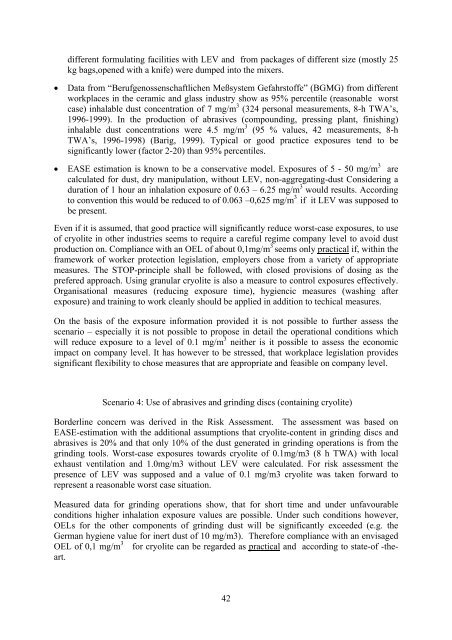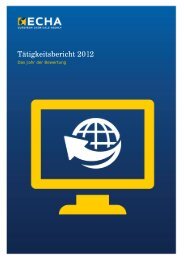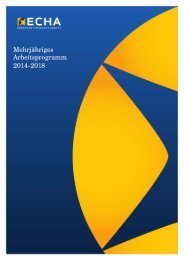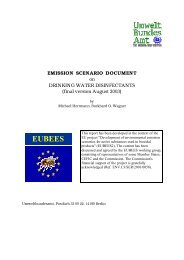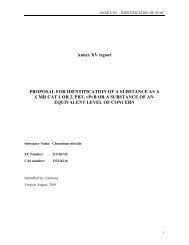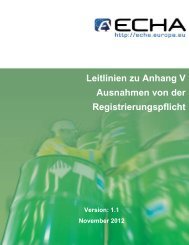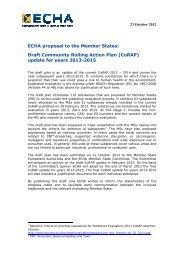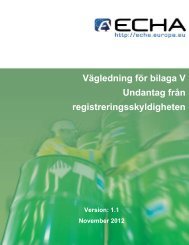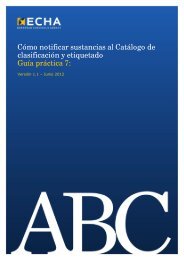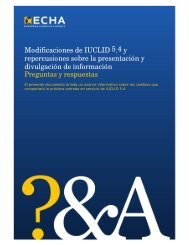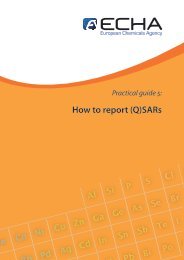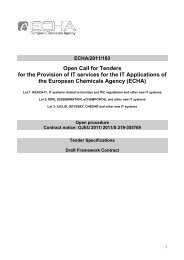Strategy For Limiting Risks Human Health Draft of ... - ECHA - Europa
Strategy For Limiting Risks Human Health Draft of ... - ECHA - Europa
Strategy For Limiting Risks Human Health Draft of ... - ECHA - Europa
You also want an ePaper? Increase the reach of your titles
YUMPU automatically turns print PDFs into web optimized ePapers that Google loves.
different formulating facilities with LEV and from packages <strong>of</strong> different size (mostly 25<br />
kg bags,opened with a knife) were dumped into the mixers.<br />
• Data from “Berufgenossenschaftlichen Meßsystem Gefahrst<strong>of</strong>fe” (BGMG) from different<br />
workplaces in the ceramic and glass industry show as 95% percentile (reasonable worst<br />
case) inhalable dust concentration <strong>of</strong> 7 mg/m 3 (324 personal measurements, 8-h TWA’s,<br />
1996-1999). In the production <strong>of</strong> abrasives (compounding, pressing plant, finishing)<br />
inhalable dust concentrations were 4.5 mg/m 3 (95 % values, 42 measurements, 8-h<br />
TWA’s, 1996-1998) (Barig, 1999). Typical or good practice exposures tend to be<br />
significantly lower (factor 2-20) than 95% percentiles.<br />
• EASE estimation is known to be a conservative model. Exposures <strong>of</strong> 5 - 50 mg/m 3 are<br />
calculated for dust, dry manipulation, without LEV, non-aggregating-dust Considering a<br />
duration <strong>of</strong> 1 hour an inhalation exposure <strong>of</strong> 0.63 – 6.25 mg/m 3 would results. According<br />
to convention this would be reduced to <strong>of</strong> 0.063 –0,625 mg/m 3 if it LEV was supposed to<br />
be present.<br />
Even if it is assumed, that good practice will significantly reduce worst-case exposures, to use<br />
<strong>of</strong> cryolite in other industries seems to require a careful regime company level to avoid dust<br />
production on. Compliance with an OEL <strong>of</strong> about 0,1mg/m 3 seems only practical if, within the<br />
framework <strong>of</strong> worker protection legislation, employers chose from a variety <strong>of</strong> appropriate<br />
measures. The STOP-principle shall be followed, with closed provisions <strong>of</strong> dosing as the<br />
prefered approach. Using granular cryolite is also a measure to control exposures effectively.<br />
Organisational measures (reducing exposure time), hygiencic measures (washing after<br />
exposure) and training to work cleanly should be applied in addition to techical measures.<br />
On the basis <strong>of</strong> the exposure information provided it is not possible to further assess the<br />
scenario – especially it is not possible to propose in detail the operational conditions which<br />
will reduce exposure to a level <strong>of</strong> 0.1 mg/m 3 neither is it possible to assess the economic<br />
impact on company level. It has however to be stressed, that workplace legislation provides<br />
significant flexibility to chose measures that are appropriate and feasible on company level.<br />
Scenario 4: Use <strong>of</strong> abrasives and grinding discs (containing cryolite)<br />
Borderline concern was derived in the Risk Assessment. The assessment was based on<br />
EASE-estimation with the additional assumptions that cryolite-content in grinding discs and<br />
abrasives is 20% and that only 10% <strong>of</strong> the dust generated in grinding operations is from the<br />
grinding tools. Worst-case exposures towards cryolite <strong>of</strong> 0.1mg/m3 (8 h TWA) with local<br />
exhaust ventilation and 1.0mg/m3 without LEV were calculated. <strong>For</strong> risk assessment the<br />
presence <strong>of</strong> LEV was supposed and a value <strong>of</strong> 0.1 mg/m3 cryolite was taken forward to<br />
represent a reasonable worst case situation.<br />
Measured data for grinding operations show, that for short time and under unfavourable<br />
conditions higher inhalation exposure values are possible. Under such conditions however,<br />
OELs for the other components <strong>of</strong> grinding dust will be significantly exceeded (e.g. the<br />
German hygiene value for inert dust <strong>of</strong> 10 mg/m3). Therefore compliance with an envisaged<br />
OEL <strong>of</strong> 0,1 mg/m 3 for cryolite can be regarded as practical and according to state-<strong>of</strong> -theart.<br />
42


